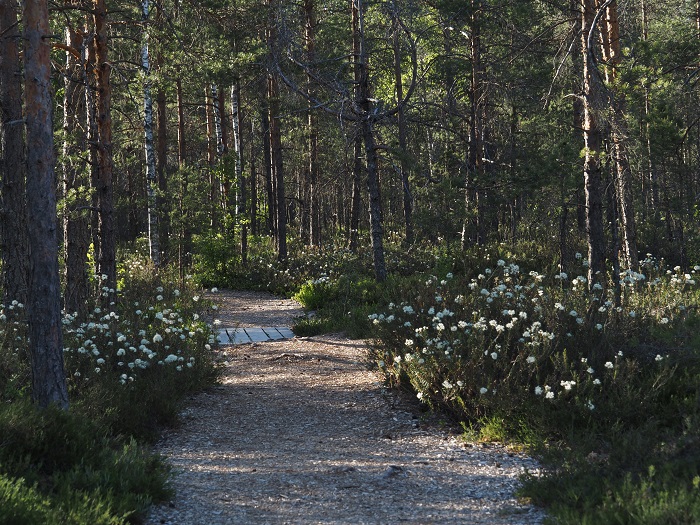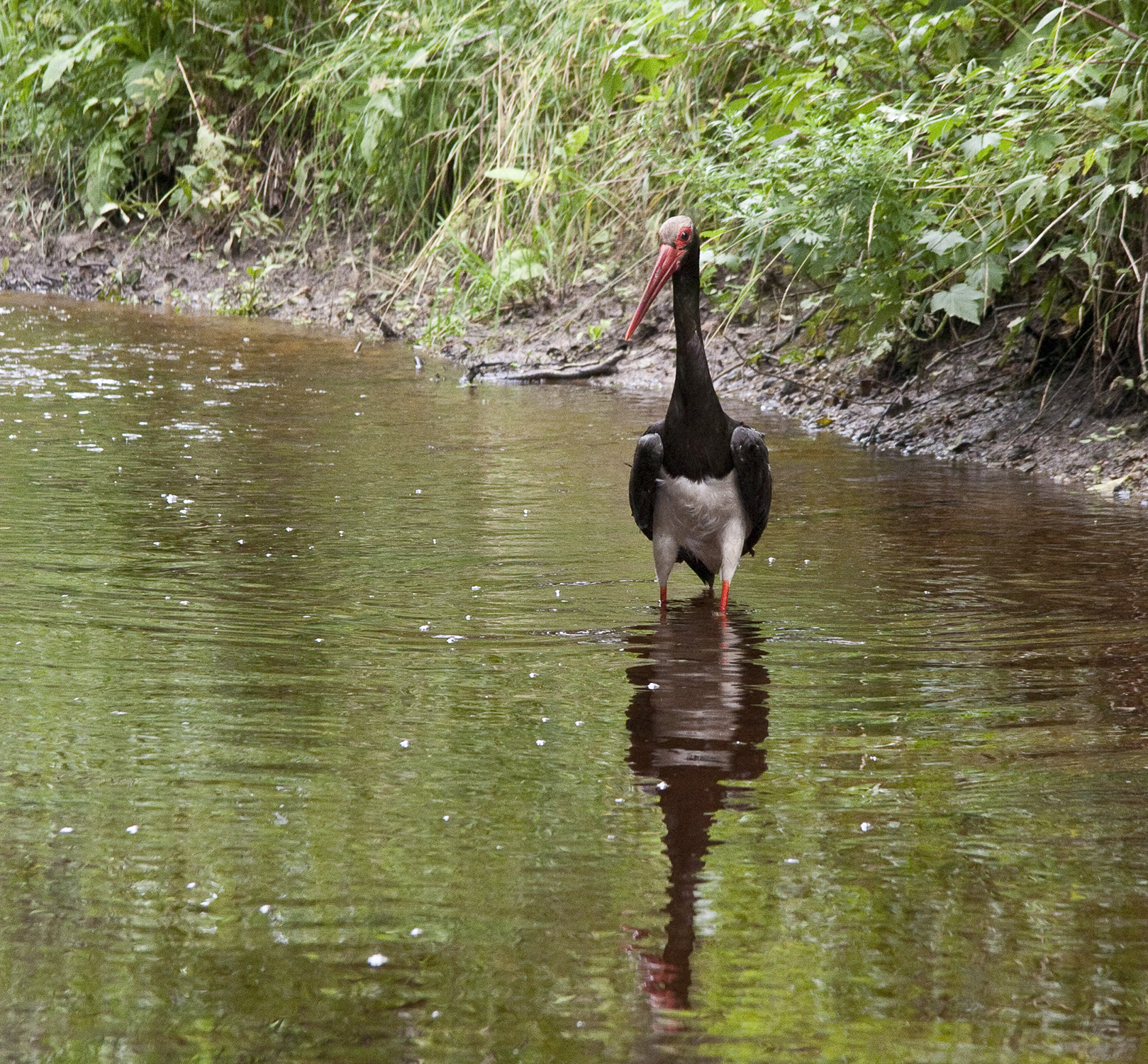Природа
Отличительной чертой природы природоохранной территории в первую очередь является болото, окруженное разнообразными лесами. Оно является сердцем круговорота воды в этой местности. Охраняемое верховое болото состоит из болота Мукри на севере и болота Элламаа на юге. Болота названы в честь близлежащих одноименных деревень. Два болота часто называют общим названием — болото Мукри.
Верховое болото
Верховое болото названо по высокому слою торфа. Поэтому верховое болото всегда выше окружающей местности. Верховое болото – последняя стадия развития болота, когда слой накопившегося торфа настолько высок, что корневая система растений не достигает богатой питательными веществами минеральной почвы или грунтовых вод. Торф – это не полностью разложившаяся растительная масса, органический осадок, который образуется из-за чрезмерно влажной, бедной кислородом и кислой среды. Торфяная почва бедна питательными веществами, поэтому своеобразная растительность болота получает питательные вещества в основном за счет содержащейся в осадках пыли. Средняя толщина торфяного слоя болота Мукри составляет 4,6 м, а самые глубокие слои достигают 8,5 м.
В заповеднике Мукри болото является типом местообитания с наибольшей площадью, составляя немногим более половины природоохранной территории, 51%. В южной части болот Элламаа и Мукри встречаются переходные болота, одни являются естественными, а другие возникли на месте бывших торфоразработок. В центральной части болота формируется облесенное верховое болото, по краям расположен лес переходного и низинного болота.
Вид с походной тропы Мукри в сторону озера, где в начале лета много белых пуховок пушицы влагалищной. Эта белая пушистая головка состоит из множества семян с длинными белыми волосками.

Болото Мукри не подвергалось серьезному воздействию человеческой деятельности и поэтому в значительной степени сохранило свое естественное функционирование. Хотя торф добывали и здесь, работы проводились вручную и на небольшой площади, поэтому ущерб был невелик. В 1920-1950-е годы торф добывали торфяной кооператив «Кобра», индивидуальные производители и местный колхоз как для подстилки, так и обогрева животных. О добыче торфа напоминают канавы со стороны Эйдапере, а рядом с дощатым настилом, ведущим от гравийной дороги прямо к озеру, видны небольшие торфяные ямы и скирды. В западной части болота была проведена подготовка к добыче торфа, в южной части находятся 55 га старых карьеров, которые были выкопаны лопатой. В прошлом веке, до образования природоохранной территории, была вырыта дренажная канава, что плохо сказалось на ценности территории. В результате дренирования часть озерков заросла. Планируется закрыть канавы, чтобы восстановить первоначальный водный режим пострадавших от деятельности человека территорий вместе с местами обитания.
Вид на походную тропу в лесу на верховом болоте с очередным мостиком через бывшую дренажную канаву.

Водная система
Торф впитывает и удерживает много воды. В торфе естественного болота в среднем 90% воды. Таким образом, большая часть воды природоохранной территории находится в торфе болота, где скапливается вода осадков. Вода, вытекающая из более высокой центральной части болота Мукри, попадает в ручьи Имси и Ваки и реку Массу. Эти проточные воды впадают в реку Вяндра, которая несет воду дальше через реку Пярну в Рижский залив Балтийского моря. Круговорот воды в болоте оказывает большое влияние как на предотвращение наводнений на прилегающих территориях, так и на смягчение последствий засухи.
Болото Мукри богато мочажинами и озерками. Озерко – это водяное оконце со свободной водой в торфяном грунте. Озерки характерны для старых болот. Мочажины – более низкие и более обводненные места на поверхности болота, но все же покрытые растительностью.
Вид на озерко на болоте Элламаа. Озерко – это водяное оконце со свободной водой на болотном ландшафте, отличающееся от мочажины тем, что у последней обводненная и более низкая часть поверхности болота все же покрыта торфяным мхом.

В северной части болота Элламаа находится несколько озер, самое большое из которых – озеро Эйдапере площадью 2,2 га. На берегу озера образовался зыбун. Длина озера составляет 340 м, ширина – 100 м, длина четко очерченной береговой линии – 1605 м. Как и в типичных болотных озерах и озерках, вода озера Эйдапере коричневатая из-за торфа и гуминовых веществ. Гуминовые вещества представляют собой содержащиеся в торфе нерастворимые в воде органические соединения. Такие водоемы являются местом обитания редких планктеров, характерных для северных регионов. Планктер – это крошечный организм, дрейфующий в толще воды. На озере Эйдапере есть три торфяных острова, которые не связаны с минеральным грунтом. В озере в изобилии растут как белые, так и снежно-белые кувшинки. Оба охраняемых вида являют собой прекрасное зрелище во время цветения (июнь-июль).
Озерцо в природном ландшафте. Посреди озера – круглый островок с низковатыми деревьями.

Леса
Наиболее распространенным лесным сообществом в заповеднике Мурки являются леса на верховом болоте и леса переходного болота, общей площадью 234 га, что составляет 11% природоохранной территории. Эти леса являются подходящей средой обитания для глухарей. В северной части природоохранной территории и по окраинам болота сохранились старые девственные леса, составляющие 3% от охранной территории. Старые девственные леса – это старые леса, в которых практически не велась человеческая деятельность и где со временем сформировались благоприятные места обитания для многих видов, находящихся сейчас под угрозой исчезновения. Находящиеся под угрозой исчезновения виды есть как среди мхов, лишайников, грибов, так и животных.
Старые девственные леса – это еще и богатые разнотравьем ельники, которых в заповеднике Мукри всего 1 га. Такие леса растут на участках с хорошим водоснабжением, где грунтовые воды проходят близко к поверхности, а почва богата питательными веществами. Эти леса представляют собой древостой с ровнядью и елью.
На юге болота Мукри на площади 11 га находится представительное сообщество болотных и заболоченных лиственных лесов. Для этой лесной среды обитания также характерно близкое расположение грунтовых вод, которые во время весеннего паводка могут достигать поверхности земли. В таких условиях вокруг нижней части ствола деревьев образуются так называемые приствольные кочки.
На природоохранной территории также встречается сильно осушенная марь с большим количеством густого валежника, пней и других элементов, увеличивающих разнообразие лесных местообитаний. Часто эти элементы важны в качестве среды обитания для редких видов, таких как мхи и лишайники.
Луга – полуестественные лугопастбищные угодья
Луга как полуестественные лугопастбищные угодья стали редкостью, из-за чего под угрозой оказались места обитания и питания связанных с этими сообществами видов. В восточной части заповедника Мурки расположены почти пять гектаров лугов с лисохвостом луговым и кровохлебкой аптечной. Лугопастбищные угодья, вероятно, использовалось в качестве полей, а также умеренно удобрялись, поэтому видовой состав обеднел. Для сохранения сообщества нужно продолжение человеческой деятельности – покос.
Охраняемые виды
В заповеднике Мукри встречаются многие виды, в том числе охраняемые. Из охраняемых видов цели охраны Мукри были установлены для четырех видов растений. Это относящаяся к I категории защиты орхидея надбородник безлистный и относящиеся ко II категории защиты осока мегалланская и орхидеи ладьян трехнадрезный и тайник сердцевидный.
Кроме того, из охраняемых видов здесь растут относящиеся ко II категории защиты болотная мякотница и пушица стройная, а также относящиеся к III категории защиты гудайера ползучая, баранец обыкновенный, белая кувшинка, снежно-белая кувшинка, пальчатокоренник пятнистый и пальчатокоренник Фукса.
Среди животных в заповеднике Мукри особое внимание уделяется трем видам птиц – черному аисту, глухарю и ястребу-тетеревятнику.

Урмас Селлис
Черный аист – относящаяся к I категории защиты перелетная птица отряда аистообразных. В Эстонии вид находится в критическом состоянии, его численность сократилась с 250 гнездящихся пар в начале 1980-х годов до 40-60 пар в настоящее время. Причина – потеря подходящих мест питания и обитания вследствие человеческой деятельности. Черному аисту в качестве местообитания подходит только тенистый старый девственный лес вблизи проточных водоемов. Помимо черного аиста, в таких старых девственных лесах могут обитать до 400 других видов, находящихся под угрозой исчезновения. Черный аист называется зонтичным видом по отношению к другим видам, находящимся под угрозой исчезновения, потому что защита черного аиста обеспечивает защиту всех остальных видов.
С 2008 года самыми известными черными аистами Мукри считаются молодой самец Осс и его птенец Оссипоэг. Летом 2008 года исследователи дали им имена и надели на них радиопередатчики. С помощью радиопередатчика миграция обеих птиц фиксировалась в 2008 году, а передвижения Осса – до 2011 года.

Глухарь – оседлая птица отряда курообразных, относящаяся ко II категории защиты с уменьшающейся численностью. Глухарь известен брачными играми среди самцов весной. Заповедник Мукри является важной средой обитания глухаря, поскольку по нему проходит «связующий коридор» к другим близлежащим местообитаниям глухарей. На болоте Мукри подтверждено наличие двух токовищ с шестью самцами.
Ястреб-тетеревятник относится ко II категории защиты и является спорадически распространенной в Эстонии оседлой птицей. Его численность значительно сократилась из-за интенсивного ведения лесного хозяйства. Ястреб-тетеревятник давно гнездится на территории Мукри, и предпринимаются попытки для сохранения этой ситуации. Этот район благоприятен для ястреба-тетеревятника, потому что речь идет о значимом местообитании глухаря, который является одним из объектов охоты ястреба-тетеревятника.
Из других охраняемых видов животных в заповеднике Мукри живут относящийся ко II категории защиты трехпалый дятел и относящиеся к III категории защиты тетерев, серый сорокопут, обыкновенный жулан, деряба, клест-сосновик, травник, фифи, большой улит, серый журавль, канюк и перепелятник.
